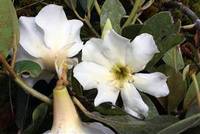Scientists hail discovery of hundreds of new species in remote New Guinea
By Terry Kirby, Chief Reporter
Published: 07 February 2006 An astonishing mist-shrouded "lost world" of previously unknown and rare animals and plants high in the mountain rainforests of New Guinea has been uncovered by an international team of scientists.
Among the new species of birds, frogs, butterflies and palms discovered in the expedition through this pristine environment, untouched by man, was the spectacular Berlepsch's six-wired bird of paradise. The scientists are the first outsiders to see it. They could only reach the remote mountainous area by helicopter, which they described it as akin to finding a "Garden of Eden".
In a jungle camp site, surrounded by giant flowers and unknown plants, the researchers watched rare bowerbirds perform elaborate courtship rituals. The surrounding forest was full of strange mammals, such as tree kangaroos and spiny anteaters, which appeared totally unafraid, suggesting no previous contact with humans.
Bruce Beehler, of the American group Conservation International, who led the month-long expedition last November and December, said: "It is as close to the Garden of Eden as you're going to find on Earth. We found dozens, if not hundreds, of new species in what is probably the most pristine ecosystem in the whole Asian-Pacific region. There were so many new things it was almost overwhelming. And we have only scratched the surface of what is there." The scientists hope to return this year.
The area, about 300,000 hectares, lies on the upper slopes of the Foja Mountains, in the easternmost and least explored province of western New Guinea, which is part of Indonesia. The discoveries by the team from Conservation International and the Indonesian Institute of Sciences will enhance the island's reputation as one of the most biodiverse on earth. The mountainous terrain has caused hundreds of distinct species to evolve, often specific to small areas.
The Foja Mountains, which reach heights of 2,200 metres, have not been colonised by local tribes, which live closer to sea level. Game is abundant close to villages, so there is little incentive for hunters to penetrate up the slopes. A further 750,000 hectares of ancient forest is also only lightly visited.
One previous scientific trip has been made to the uplands - the evolutionary biologist and ornithologist Professor Jared Diamond visited 25 years ago - but last year's mission was the first full scientific expedition.
The first discovery made by the team, within hours of arrival, was of a bizarre, red-faced, wattled honeyeater that proved to be the first new species of bird discovered in New Guinea - which has a higher number of bird species for its size than anywhere else in the world - since 1939. The scientists also found the rare golden-fronted bowerbird, first identified from skins in 1825. Although Professor Diamond located their homeland in 1981, the expedition was able to photograph the bird in its metre-high "maypole" dance grounds, which the birds construct to attract mates. Male bowerbirds, believed to be the most highly evolved of all birds, build large and extravagant nests to attract females.
The most remarkable find was of a creature called Berlepsch's six-wired bird of paradise, named after the six spines on the top of its head, and thought "lost" to science. It had been previously identified only from the feathers of dead birds.
Dr Beehler, an expert on birds of paradise, which only live in northern Australia and New Guinea, said: "It was very exciting, when two of these birds, a male and a female, which no one has seen alive before ... came into the camp and the male displayed its plumage to the female in full view of the scientists."
Scientists also found more than 20 new species of frogs, four new butterflies, five new species of palm and many other plants yet to be classified, including what may be the world's largest rhododendron flower. Botanists on the team said many plants were completely unlike anything they had encountered before.
Tree kangaroos, which are endangered elsewhere in New Guinea, were numerous and the team found one species entirely new to the island. The golden-mantled tree kangaroo is considered the most beautiful but also the rarest of the jungle-dwelling marsupials. There were also other marsupials, such as wallabies and mammals that have been hunted almost to extinction elsewhere. And a rare spiny anteater, the long beaked echidna, about which little is known, allowed itself to be picked up by hand. Dr Beehler said: "What was amazing was the lack of wariness of all the animals. In the wild, all species tend to be shy of humans, but that is learnt behaviour because they have encountered mankind. In Foja they did not appear to mind our presence at all.
"This is a place with no roads or trails and never, so far as we know, visited by man ... This proves there are still places to be discovered that man has not touched."
Inhabitants of New Guinea
Birds
The scientists discovered a new species - the red faced, wattled honeyeater - and found the breeding grounds of two birds of almost mythical status - the golden- fronted bowerbird and Berlepsch's six-wired bird of paradise, long believed to have disappeared as a separate species. The expedition also came across exotic giant-crowned pigeons and giant cassowaries - a huge flightless bird - which are among more than 225 species which breed in the area, including 13 species of birds of paradise. One scientist said that the dawn chorus was the most fantastic he had ever heard.
Mammals
Forty species of mammals were recorded. Six species of tree kangeroos, rare elsewhere in New Guinea, were abundant and the scientists also found a species which is new to Indonesia, the golden-mantled tree kangeroo. The rare and almost unknown long-beaked echidna, or spiny anteater, a member of a primitive group of egg-laying mammals called monotremes, was also encountered. Like all the mammals found in the area, it was completely unafraid of humans and could be easily picked up, suggesting its previous contact with man was negligible.
Plants
A total area of about one million hectares of pristine, ancient, tropical, humid forest containing at least 550 plants species, many previously unknown and including five new species of palms. One of the most spectacular discoveries was a so far unidentified species of rhododendron, which has a white scented flower almost six inches across, equalling the largest recorded rhododendron flower.
Butterflies
Entomologists among the scientists identified more than 150 different species of butterfly, including four completely new species and several new sub-species, some of which are related to the common English "cabbage white" butterfly. Other butterflies observed included the rare giant birdwing, which is the world's largest butterfly, with a wingspan that stretches up to seven inches.
Frogs
The Foja is one of the richest sites for frogs in the entire Asia-Pacific region, and the team identified 60 separate species, including 20 previously unknown to science, one of which is only 14mm big. Among their discoveries were healthy populations of the rare and little-known lace-eyed frog and a new population of another frog, the Xenorhina arboricola, which had previously only been known to exist in Papua New Guinea.
An astonishing mist-shrouded "lost world" of previously unknown and rare animals and plants high in the mountain rainforests of New Guinea has been uncovered by an international team of scientists.
Among the new species of birds, frogs, butterflies and palms discovered in the expedition through this pristine environment, untouched by man, was the spectacular Berlepsch's six-wired bird of paradise. The scientists are the first outsiders to see it. They could only reach the remote mountainous area by helicopter, which they described it as akin to finding a "Garden of Eden”. |












